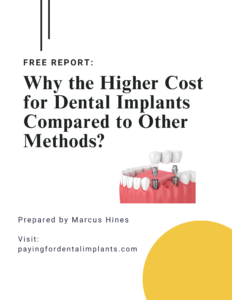Physical Address
12245 Cypress Spring Road, Clarksburg, MD 20871
Physical Address
12245 Cypress Spring Road, Clarksburg, MD 20871

Last updated on April 2nd, 2025 at 12:08 am
Satisfying the cost of dental implants can require a thoughtful process, especially if multiple implants are required. We have done the thinking for you here. There are several ways that patients typically go about paying for their dental implant procedures. In this section we will outline a few options for you to consider that can make your dental implant treatment more affordable and immediately accessible.
There are multiple lenders in the dental and medical space who will extend you credit for your dental implant procedure. These lenders are commonly referred to as patient finance companies. Patient finance is a popular option used every day by dental implant patients to make their treatment affordable. Since repayment terms may be extended over several years, this option is worth strong consideration.
Certain patient finance companies will extend as much as $75,000 to $100,000 with repayment terms extended as far out as 12 years. Since large implant procedures can cost as much as $20,000 – $60,000, lengthy repayment terms can make treatment affordability. A high credit score can land you an interest rate as low as 5.9%.
A few of the more common patient financing companies include:
In Winston’s dental implant story you will discover how his patient finance loan made his dental implant treatment affordable. We’ve ranked the top patient finance companies on our Best Patient Finance Companies page.
Zero- and low-interest credit card promotions are worth considering when it comes to making your dental implant procedure affordable. NerdWallet is a great credit card resource to begin with.
The onetime flat fee of between 3% to 6% that you’ll be charged to access to interest-free funds is a small price to pay given its invaluable healthcare purpose. But before you open a new account, first check your established credit cards promotions. It could be that at least one of your credit cards is offering a 0% APR promotional rate.
In the event that you are not able to repay the portion of your implant treatment — charged to your credit card — by the end of your interest-free promotion period, consider transferring the remaining balance to another creditor that offer a low interest rate until you can clear your balance.
A Flexible Spending Account (FSA) is a special account funded by an employee’s pre-tax earnings. An FSA is specifically designed to pay for certain out-of-pocket health care expenses, like dental implants. In 2025, an employee may choose to contribute up to $3,300 to an FSA.
Use of an FSA includes deductibles, copayments, and other health-related expenses not covered by insurance. The money deducted for an FSA comes from your earnings, before taxes are taken out. Since an FSA reduces the amount of payroll taxes from your check, it is a smart benefit.
It is important to note that in 2025 FSA funds must be used in the same calendar year that your contributions are made, except for up to $660. Any unused FSA funds above $660 will be lost. Visit our FSA are Making Implants Affordable page for more details.
Since contributions are automatically withheld from your paycheck and deposited into your FSA account, this will help you budget for expenses like dental implant treatment.

A Health Savings Account (HSA) has several great benefits including tax savings and interest bearing capabilities. If you ever needed the ultimate payment plan for dental implants, this may be it.
An HSA works similarly to an FSA, with added advantages. Different from an FSA, any unused funs contributed to an HSA will rollover entirely each year. This allows your contributions to accumulate and grow year-over-year.
In my recent HSA article I explain in depth how this savings strategy will allow you to deposit pre-tax dollars into a dedicated account which may be used for qualified medical and dental expenses.
In 2025, the maximum allowable HSA contribution is $4,300 for individuals and $8,550 for families. Also, an HSA is capable of earning interest and the gains are tax-free when the funds are used for qualifying expenses. This provides a potential growth benefit beyond your contributions.
If you are planning ahead for your dental implant procedure, an HSA can be an excellent way to budget for it over the course of a few years. You can then use these pre-tax dollars to fund your treatment.
Consider Karen’s dental implant story and how she used $20,000 from her HSA plan to make her implant procedure affordable. Speak with your HR department for specific details on what having an HSA plan would mean for you.
A Home Equity Line of Credit (HELOC) is a type of loan that allows homeowners to borrow against the equity that they’ve built. Equity is the difference between the value of the home and any outstanding mortgage balance.
A HELOC works much like a credit card; it provides a revolving line of credit. This means you can borrow up to a certain limit, pay it back, and then borrow again as needed. Major purchases like a full mouth dental implant procedure could be a very good reason to leverage the power of a HELOC.
Advantages of using a HELOC for dental implant treatment includes flexibility in borrowing and repayment, lower interest rates, potential tax deductions, and large credit limits.
While a HELOC can offer convenient and cost-effective financing, it’s crucial to remember that your home secures the loan. Therefore, failure to repay the loan can put your home at risk of foreclosure. It is always important to consider your repayment capacity before opting for a HELOC.
When facing a significant expense like a full mouth dental implant procedure that can cost as much as $20,000 – $60,000, consider borrowing from your retirement fund. All things considered, tapping into a 401(k), 403(b), 457(b) or IRA for a loan may be a very wise choice.
Borrowing from a retirement fund includes a few favorable conditions:
It is important to understand that failure to repay a 401(k) loan within the allotted period could lead to taxes and penalties. Never borrow more than you can afford to repay.
Many individuals who are candidates for dental implants do not realize that they may be in a great position to withdraw funds from their retirement accounts without penalty. Several people routinely take advantage of this option to pay for needed dental care. Here are a few requirements to consider:
As long as you are at least 59½, this option can make it possible for you to immediately receive your needed dental implant procedure, without penalty. Consider Cheryl’s dental implant story.
She made her implant treatment affordable by leveraging a $30,000 withdrawal from her husband’s 401(k) plan. Because her husband is 60 years old, there were no penalties.
Given that this option will ultimately reduce your retirement savings, it is advisable to speak with a certified financial planner before choosing this option.
Calling on family members to assist in helping with the cost of dental implant treatment is quite common. Perhaps there is a favorite aunt or uncle who is in a financial position to support you. Your retired parents may be seeking opportunities to gift funds from a retirement account or face a penalty. This is known as a Required Minimum Distributions (RMD).
Your children don’t have to be rich in order to come together on you behalf. Consider Ronald’s story. His children came together to make his implant procedure financially possible. They formulated a plan and divided the costs among themselves.
If you have children and/or other family members who want nothing less than good health for you, it may be a good idea to show them how they can help you.
Ideal approaches for communicating your requests include the following steps:
Whether it’s applying for a person loan through a dental finance company, establishing a health savings account, using a home equity line of credit or some other form of payment, making a large dental implant procedure affordable often requires exhausting several options.
The costs of dental implant treatment does not have to be insurmountable. Most dental implant recipients are not rich, but when necessary, they become resourceful and even creative to make their treatment affordable. Dental implants can be life changing. Consider all financial resources responsibly and reclaim your health and confidence in your smile.

This will close in 0 seconds
This will close in 0 seconds
[…] our page on Making Dental Implant Treatment Affordable for several ideas on making this procedure […]
[…] insights on using one or more of these financial options, visit the Making Dental Implant Treatment Affordable […]
[…] patients will finance this procedure over several years, much like purchasing a car. Visit Making Dental Implant Treatment Affordable for ideas on how you can cover the cost of your needed dental implants […]
[…] dental office encouraged you to visit the Making Dental Implant Treatment Affordable page for several up to date ideas and resources for making dental implant treatment affordable. […]
[…] visit our Making Dental Implant Treatment Affordable page for additional great recommendations for making implant treatment […]
[…] Retirement Fund Loan: A 401(k) or 403(b) retirement fund and the like allow contributors to borrow funds at low interest rates, usually for up to five (5) years. The interest charges are deposited back into the individual’s fund. It is quite common for patients to borrow from a retirement fund to cover at least a portion of their implant treatment. For more details on this subject visit Borrowing From a Retirement Fund. […]